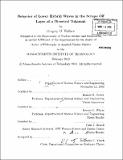Behavior of lower hybrid waves in the scrape off layer of a diverted tokamak
Author(s)
Wallace, Gregory M
DownloadFull printable version (32.19Mb)
Other Contributors
Massachusetts Institute of Technology. Dept. of Nuclear Science and Engineering.
Advisor
Ronald R. Parker.
Terms of use
Metadata
Show full item recordAbstract
The goal of the Lower Hybrid Current Drive (LHCD) system on the Alcator C-Mod tokamak is to investigate current profile control under plasma conditions relevant to future devices such as ITER and DEMO. This thesis addresses the behavior of Lower Hybrid (LH) waves in the edge and Scrape Off Layer (SOL) of Alcator C-Mod, a compact, high field, high density, diverted tokamak. The results of coupling experiments over a range of plasma parameters in both Land H-mode plasmas are presented. Experimental observations suggest that power absorption in the SOL (from both Ion Cyclotron Heating and LHCD sources) modifies the density profile in the vicinity of the LH launcher, thereby affecting the coupling of LH waves. An analysis of the damage sustained by the LH launcher also shows absorption of the LH waves in the SOL near the antenna. Estimates of the heat flux sustained by the antenna during high power LHCD are in agreement with measurements of the density and temperature increase on flux tubes intersecting the antenna. Power absorption due to high parallel refractive index modes and collisional absorption are not sufficient to explain the increase in density and temperature of the plasma in front of the antenna. Experimental observations of the LHCD "density limit" for C-Mod are presented. (cont.) Bremsstrahlung emission and relativistic electron cyclotron emission from fast electrons in the core plasma drop suddenly above line averaged densities of 10 20 m -3 , well below the previously observed density limit. These experimental data are compared to both conventional modeling, which gives poor agreement with experiment above the density limit, and a model including edge collisional absorption, which dramatically improves agreement with experiment above the density limit. Combined together, these results show that strong absorption of LH waves in the SOL is possible on a high density tokamak. The paradigm of computationally treating the plasma core and edge as two separate regions with no or weak interaction fails when compared with the C-Mod results. These observations have spurred a shift towards simulating the core and SOL plasma together in predictive simulations of LHCD.
Description
Thesis (Ph. D.)--Massachusetts Institute of Technology, Dept. of Nuclear Science and Engineering, 2010. Cataloged from PDF version of thesis. Includes bibliographical references (p. 237-245).
Date issued
2010Department
Massachusetts Institute of Technology. Department of Nuclear Science and EngineeringPublisher
Massachusetts Institute of Technology
Keywords
Nuclear Science and Engineering.